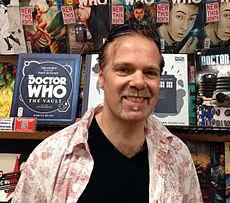
Nick Abadzis works on the ongoing Tenth Doctor series from Titan Comics. He recently gave an interview to Martin Hudecek of Doctor Who News
How exciting is it knowing that there is a couple of other regular series being made with the Tenth Doctor's successors at the same time?
It’s nice to know you’re in such good and esteemed company. I talk to Robbie Morrison and Cavan Scott a fair bit and I admire Al and Rob’s work very much, so there’s a sense that we’re all “keeping the flame.” Apart from the TV show, and all the other spin-off media, I’ve read Doctor Who comics since I was a little kid, so it’s an amazing thing for me to be a part of this.
Where is the 10th doctor at in his timeline? And what impact does this have on the friendship with Gabriella - the new companion you have introduced?
These stories take place after Donna Noble left the TARDIS. They’re how the TV show might’ve continued on TV for a fourth full season of David Tennant in the role of the tenth Doctor. After what happened to Donna, he’s in quite a dark place and very, very cautious about taking on any other long term travelling companions. He doesn’t want to endanger anybody else and that does have a bearing on how he deals with Gabby at first. She has to win his trust, but also his willingness to even see her as a potential friend, because he’s very much aware that just by being with him, she’s in a dangerous position. Initially at least, he doesn’t really trust himself to look after anyone, so any potential companion has to be able to take care of herself.
Did you try and recapture David Tennant's sheer zest, and match it with the type of stories you tell?
To a certain extent, just the enormous energy and joie de vivre David Tennant brought to the role of the tenth Doctor propels a story with its own momentum, because you’re writing for that same character, that same spirit. Any Doctor has his own particular cadences and mannerisms, but you can’t just repeat what you heard him say on TV, because the way he speaks must continue to evolve and be responsive to the situation he finds himself in. While it isn’t exactly easy, I have a good time writing him, because I am very fond of that particular Doctor. Equally, you’re trying to recapture a general sense of the RTD era, of its many layers, without trying to be slavish about it; to continue it and reveal hidden new depths to it. I want to generate new kinds of chemistry for him, with new characters and unfold wholly unexpected directions and mythology.
Of course, any Doctor lives longer and in a more labyrinthine fashion than any of us mere mortals are privy to, but the aim is to shed some light on these hidden moments in the tenth Doctor’s timeline. As far as I’m concerned he is still very much a living, breathing character and I try to invest in him all that nuance, pathos and fun that David Tennant gave him onscreen, and I am very lucky to have my scripts drawn by Elena Casagrande, who I know loves him even more than I do.
Which time zone(s) have you set these stories in and why?
Why, all of time and space of course! Without being facetious, it’s GMT+5 – the east coast of the USA. Gabby Gonzalez is a Mexican-American from Brooklyn, New York City, where the Doctor first meets her. Like Rose, Martha and Donna before her, this means to a certain extent she has a tie to her hometown, so there’ll be a few return journeys to the Big Apple. I’m writing our first “season finale” at the moment, much of which is set there, and it’s epic.
Are the 'cliffhangers' a big focus for you in the creative process of writing serialised Doctor Who?
I do love a good cliffhanger, probably because I was brought up on them with the classic show. You always try and write in a good reason to make a reader want to pick up the next installment, of course, it’s part of the tradition.
Are there clear heroes and villains in your stories and why?
My first set of villains are very clearly bad guys, quite singular in their intentions and nastiness, although they are not really responsible for being that way – they were created with a very specific set of traits in mind, to be an invasion force. The villains in the next story are a rather more surreal pair, who came into being entirely by accident, through sheer force of creativity. I’m writing a “big bad” for the final arc this year at the moment who is an entirely different beast again, who is not even a villain precisely. He’s something of a sleeping giant, someone who was best left asleep. He’s quite grumpy when his “alarm clock” wakes him, and he decides he needs the Doctor’s help – help that the Doctor is disinclined to give. From small misunderstandings and demands, drama and a lot of heartache ensues. I like to give all my villains some tiny element of sympathy, so their darkness holds an understandable allure.
Is there a preference for having the Doctor or the companion drive the narrative in the stories?
There are different ways of telling stories, and I try to mix it up so it isn’t all one perspective or another. Sometimes, it’s from the Doctor’s point of view, sometimes the companion’s, sometimes another character’s, even the villain’s. In comics, you do have that luxury, and it isn’t always as jarring a switch as it might be in another medium like TV or the written word, because you float a lot of those changes on the visuals and the pacing. Comics is a language, and a far, far more sophisticated one than some people give it credit for, but as we now live in a world where comics grammar is used on a daily basis, where it’s colonized smartphones and desktop computing, I’d say we were ahead of the game.
Which other tv /film comic books have you done or might do one day?
I’m probably best known for a graphic novel called LAIKA, in the UK for my work on Deadline and a character called Hugo Tate (for readers of a certain age). As well as Doctor Who, I'm also currently working on a project for First Second, the same publisher as LAIKA. It's called Pigs Might Fly and yes, it's about flying pigs. You can stay tuned to my Twitter feed or Tumblr for updates on all my upcoming projects, including the good Doctor.
What are your all time favourite comic stories or graphic novels? (e.g top 3, top 5)?
This changes all the time. Among perrenial favourites, I’d list:
The Incal – Moebius and Jodorowsky
The Love Bunglers – Jaime Hernandez
Hergé – Tintin in Tibet
Alan Moore and David Lloyd – V for Vendetta
Jack Kirby – 2001 A Space Odyssey
What would you say is the highlight of your comic book career so far?
Winning an Eisner award for LAIKA, and the various other international storytelling awards that came with publication of various foreign editions. Getting to write Doctor Who ain’t bad, either.
Historical fiction has been important in your writing career thus far. If you had a working TARDIS to hand, which past events would you want to visit and why?
“You can’t change history – not one line,” isn’t that right? I suppose I should say that I’d rescue the eponymous central character of my book LAIKA. If I was being a little more self-indulgent, I’d go and see David Bowie live as the Thin White Duke on the European leg of his Station to Station tour in 1976. Maybe nip forward a year and see Iggy Pop on The Idiot tour too, with Bowie on keyboards.
Have you used your own experiences of life in the USA to give life to your stories' characters and surroundings?
Yes. Any storyteller worth their salt uses their own experiences and observations to bring their characters to life. They say write what you know, extrapolate from what you know and even the strongest flights of fancy, the best imaginative works have to be written so that a character and therefore the reader believes in them. It’s not so much about making it realistic, but making it believable.
Doctor Who: Tenth Vol. 1 hits comic stores on March 25 and books stores on March 31.
Amazon UK Link
Anazon US Link







